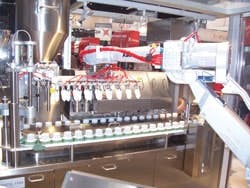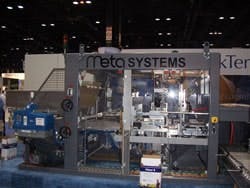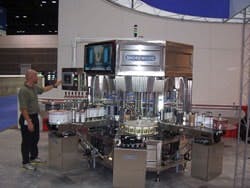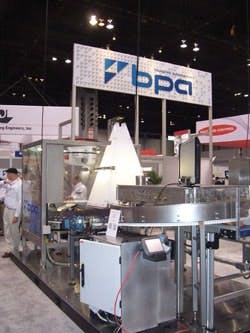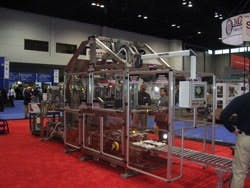Jim Montague is the executive editor for Control. Email him at [email protected].
Fortunately, many builders say they wouldn't have it any other way. In fact, some builders report they and their customers, system integrators and suppliers are so inside each other's heads that in some ways they're becoming a collective entity with a common goal of curing end user headaches.
Solving Persistent Problems
This joint mission begins with knowing that retailers want low-cost products that pop on the shelves and grab buyers' attention. This is not an easy job, and it's one of the main reasons why machine building is all about helping manufacturers deliver those products and services.
However, though many problems get solved quickly, some can endure for decades while users search in vain for solutions and dream of relief. For instance, toothpaste, cosmetics, oil paints, anchovy paste and other products have been packaged in plastic tubes for 60 years. All the while, manufacturers have struggled to find leaks after tubes are sealed, which can foul lines, hobble production and increase costly downtime, especially during changeovers. Unable to check each tube during production because seals are weak until they've cooled, most manufacturers pull samples from their lines. But it takes a lot of pressure to identify a leak, and this destructive testing yields incomplete results.
"The world has been looking for a good leak-detection system ever since we began sealing plastic tubes in the 1950s, but previously there was no way, and so it was just a dream for all those years," says Göran Adolfsson, president of Coesia Health and Beauty in Branchburg, N.J. Coesia builds consumer packaging equipment, and acquired tube-filling equipment maker Norden Machinery about five years ago. It revamped its Nordenmatic 1702 tube-filling machine with updated robotics and an innovative leak-detection system (Figure 1). "Now, by collaborating with our users and suppliers, we've developed for the first time a gas-sniffing system that injects a very detectable, inert gas into the tubes, and then squeezes them lightly to identify any leaks."
After sealing, the machine uses a simple Festo pneumatic cylinder to apply gentle pressure to each tube, and a detector checks for presence of gas at a parts per million (ppm) level. This non-destructive approach is performed quickly enough that manufacturers can check each tube without removing it from the line, reject individual tubes without stopping the line, or stop if three or more tubes are found to have leaks.
"This can save a huge amount of time and money that used to be wasted on taking samples and rejecting batches," says Bastien Fusy, Coesia's design and support engineer. "The basic filling method is pretty much the same — and even robots and servos have been accepted in tube filling for more than 10 years — but now we can achieve greater speeds with simpler programming and ease of use, and this gives users a lot more confidence. This leak-detection system solves a lot of problems for our users and for us, too."
Joined at the Hip
To deliver more vital gains and flexibility for their customers — such as halving lifecycle costs by combining two functions in one machine — some builders form long-term alliances and joint ventures with other builders, system integrators and far-flung providers.
RockTenn in Orlando, Fla., has long used single-machine exchange dies (SMEDs) from D.S. Smith Packaging in Maidenhead, U.K., to form corrugated cases around a steel mandril in RockTenn's Meta Systems machine. This makes for faster box building and eliminates much of the skew associated with traditional folding, erecting and sealing. The cases can be constructed with 30–40% less fiber, but with the same or better stacking strength.
Most recently, RockTenn and D.S. Smith developed and patented a 55-case-per-minute Meta Systems machine that combines two different substrates — craft corrugated and pre-printed, solid-fiber cartoning — into one case that can be used for both shipping and in-store display (Figure 2). "We also help users minimize costs by using an option that's like a lease, so they can keep up with the changing technology, but aren't saddled with capital expenditure costs," says Terry Huber, electrical engineer and programmer in RockTenn's automated packaging and corrugated container division. "When a customer contracts to buy our corrugated material, the machine lease is an add-on."
Servos Reanimate Poucher
Servo motors and drives are among the most useful technologies to help simplify machine designs, operations and maintenance, and limit lifecycle operating costs. Sometimes servos can even help bring a machine back to life.
Scott Fuller, intermittent motion product line manager at CMD in Appleton, Wis., says he joined the company in 2009 to help revamp its well-known PDI line of pouch-converting equipment. He and his colleagues spent the past three years redesigning and rebuilding CMD's 760 SS combined converting machine, especially its sealing process, to handle a wider range of pouch formats for medical and food products, and extend its maintenance intervals and operating life.
"We needed to leapfrog our pouch-converting equipment into the 21st century, remove its hydraulic or air cylinders that applied pressure to the pouch seals, and get rid of some clutches and brakes," Fuller explains.
Consequently, CMD implemented servo drives, PLCs and supporting software from Bosch Rexroth to improve 760 SS's force, motion control and indexing in a fully closed loop, and make sure its pouches were sealed at more precise pressure, temperature, and dwell or duration. "We'd used servo-based web control before, but this was the first we used it for sealing accuracy," Fuller says. "Now we get immediate reports when a sealing contact is made, its pressure and duration, and when it's released. If a seal is supposed to be made at 72 psi, we can set upper and lower limits, which can shut the process down if a seal is made at only 60 psi, and then tag and date stamp that event. This is especially useful for helping medical and food manufacturers set up and document production conditions, run their statistical process control software, and meet their track-and-trace requirements."
As a result of its servo-based makeover, 760 SS can run 200 laminated or Tyvek pouches per minute, and their seals can hold up in a vacuum, which is crucial because many pouches must be sterilized after packaging.
Wireless Manages Rotating Labeler
Although it's important to reduce costs in the long run, some builders report their customers want speed and other crucial capabilities first — including putting labels on tapered wine bottle necks or on square or octagonal shampoo bottles. For example, Shorewood Engineering in Waconia, Minn., added new controls, more-capable nesting stations and multi-angle labeling heads on its Model 7000 bottle-labeling machine (Figure 3), says Corey Pouchnik, controls technician.
"Our users asked for better accuracy at higher speed, so we developed nests that can independently rotate the bottles, and even change direction, which allows us to do full-wrap labeling without using extra wipes," he explains. "In the past, rotating nests usually were driven by cams on the bottom or gears in the turret, which meant they always had to run at the same speed. This was less flexible, and so more wipes were needed to apply the labels. Each of the axes in the 24 nesting stations on our Model 7000 is driven by a Bosch Rexroth servo, and they're coordinated by its combined PLC and motion controller. It also manages eight more axes, which manage the four external labeling heads, and perform material handling tasks such as feeding bottles in and moving them out."
So, how do you network and coordinate the servos on the 24 nests on the machine's carousel when they're all rotating and can't be wired? "One cool thing about Model 7000 is that we're able to use Ethernet TCP/IP and EtherNet/IP on a wireless Ethernet module for full motion control," says Jeff Bock, Shorewood's applications engineer. "This is a secure, peer-to-peer Ethernet network, so it can't be hacked."
Consequently, Model 7000 can place up to 400 labels per minute, usually two per bottle on front and back, or a third on a neck that can be angled up to 45°. Shorewood also recently implemented an optional Keyence vision system on Model 7000 to help check and orient bottles and inspect them for label placement, Pouchnik adds.
"The main benefit of Model 7000 is that it gives users the flexibility to label how they want, whether it's just front or back, or with any degree of pitch, or if they need to put labels on two sides at once," Pouchnik says. "And, when a run is over, operators can save all the turns, angles, rotation and duration information in a product recipe, so they can reuse it later. This can cut the two or three hours it takes to change over a typical label and bottle washing project to about 90 minutes."
See, Move, Pick, PlaceFigure 4: A standard-configuration packing machine and production line from BluePrint Automation includes a delta robot and a vision system for random, in-feed carton loading, but these standard pieces can be customized to serve the unique needs of individual applications.
Robots, Cameras Take Over! Ho Hum
Until recently, a customized machine solution — perhaps using a vision system to help direct a robot — was pretty exotic. However, so many new end users are demanding similar solutions for pick-and-place and other applications that formerly one-off machines are becoming common and assembled from increasingly standard components.
For instance, BluePrint Automation in Longmont, Colo., a custom machine builder and integrator, has a standard-configuration packing machine and production line that incorporates an ABB delta robot and a Cognex vision system networked via Ethernet TCP/IP or Firewire for random, in-feed carton-loading applications (Figure 4).
"We use CAD, solid modeling, finite element and flow analysis to design our customized machines, and soon we're going to build our own robot," says Joe Crompton, BluePrint's software and control director. "But for now it's simpler to use an existing delta robot because everyone is jumping on this bandwagon. Ironically, at a time when control systems are more able to adapt and work with older hardware, most new users that start to employ machines with robots, cameras and end-of-arm vacuum cups want all new components. The other double-edged sword is that, while these machines are easier to use, more affordable and have user buy-in, it's still crucial for users and operators to understand underlying issues, such as how to configure and tune these tools for their individual applications and settings. There's still some black magic involved."
There's a lot of pressure on manufacturers to automate to beat the competition, Crompton adds, but most need their new machine projects to pay off in about two years. "When they're looking at buying a machine, it's easier to justify it if it's going to be running for three shifts. It's hard to rationalize automation if it's only going to be used for one shift," Crompton says. "There's pressure on us machine builders, too, because winning a project often means making sure we can do a production line with two robots instead of three, or having a gripper that can pick up several items at high speed without exceeding the delta robot's limited payload."
Likewise, Standard-Knapp in Portland, Conn., recently overcame the challenge of helping its end users reduce partitions and other materials in their cases without breaking the beer, wine, water and other bottles inside — and use less energy, too. The builder's new Versatron machine uses a large, two-axis delta robot that achieves "zero drop" and avoids breakage by placing multiple bottles down to the bottom of each case (Figure 5).
Strong-Arm Robot, Less Broken GlassFigure 5: Standard-Knapp’s new machine uses a large, two-axis delta robot (at top) that achieves zero drop and avoids breakage by placing multiple glass bottles down to the bottom of each case.
"We worked with a customer that really needed less breakage because their machine was damaging about 10% of their cases," says Mario Mazzotta, customer service manager for field engineering at Standard-Knapp. "They literally had a guy with a shovel at the end of their line. So we visited each other's plants over several weeks, and we developed our own two-axis robot for the Versatron that's very stiff and robust, and can lift up to 100 lb using Rockwell Automation integrated servo motors and drives and controls. The servo's actuation and braking functions are smoother and gentler than our manufacturer's former case packer, and so they don't rattle or risk dropping the bottles anymore. We also installed our own gripper design that grabs below the cap and holds the neck of the bottles, and so breaks during packing have dropped to less than 1% or effectively zero."
Less Cost, More Green
One final, icing-on-the-cake bonus that comes from reducing operating and lifecycle costs is that the increased capability, flexibility and efficiency also usually results in a more sustainable process.
For instance, RockTenn and D.S. Smith's two-substrate case building machine is triply sustainable because it eliminates the need for a second machine, saves on cartoning material, and even reduces labor needed on the retail side because products don't need to be removed from the cases to be put on the shelves. "Besides building machines and production lines, we also make and recycle corrugated fiber, so we knew how much our end users could save if we combined these two substrates," RockTenn's Huber explains. "In fact, we had one customer in Mexico that was packing liquid-filled bottles in cases, and we determined the cost of their box was $1.88, while ours was 90 cents including leasing the Meta Systems machine. We also saved him about $50,000 per week in corrugated costs."
Likewise, adding servo motors, drives and controls to CMD's 760 SS pouch-converting equipment also made it a greener machine, Fuller reports. "Besides lasting infinitely longer than the cylinders, our servos use less energy, and their accuracy allows us to reduce our consumable raw materials and generate less waste along with minimizing downtime and maximizing uptime," he says.
However, Crompton cautions that using sustainable materials can pose some unexpected challenges for machine builders and end users. "Using recycled cardboard is greener, but it can be harder to handle," he says. "It can't stand up as well to all the bending, collapsing and recollapsing during case building, so machines that use it must be extremely tolerant."
Builders need to consider the lifecycle benefits at every stage of their machine's development and let it help guide design, according to Graham Harris, president of Beckhoff Automation. "The four stages are acquisition, when costs and parts can be limited; application, when speed, flexibility and ease of use can be improved; at installation, when machine footprints, cabinets and cables can be reduced; and when considering maintenance, so that reliability, simpler part replacements and quicker upgrades can be achieved."
To help reduce parts, an embedded, PC-based control system can provide multiple control functions in one package, eliminating the need for multiple controllers, Harris adds. "Likewise, standardizing on one software and using one network such as EtherCAT for logic and motion improves speed, reduces wiring and eases connectivity. Finally, using EtherCAT I/O terminals can eliminate cabling and switches, and streamline the I/O system."


